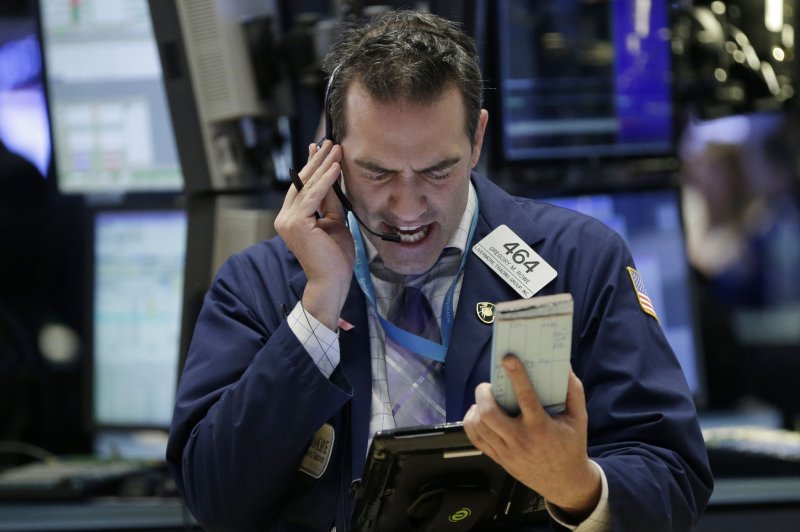The Dow Jones Industrial Average fell nearly 400 points Thursday as global fears continue about the struggling Chinese economy. The index has lost more than 1,000 points in the last five days of trading. Photo by John Angelillo/UPI |
License Photo
NEW YORK, Jan. 7 (UPI) -- Shares on the New York Stock Exchange took another tremendous beating on Wall Street Thursday -- its third in the last four days of trading -- as the Dow tumbled nearly 400 points as economic volatility continues in China.
The Dow started Thursday at 16,906.51, but had fallen to 16,514.10 by the close of business -- a drop of 392 points. The Nasdaq fell 146 points, 3 percent, to 4689.43 -- and the S&P 500 lost 47 points, 2.3 percent, to close at 1,943.09.
The tech-weighted Nasdaq has so far lost more than 6 percent since the beginning of the year -- its largest drop in 16 years.
All told, the Dow has fallen more than 1,000 points in the last five days of trading.
"U.S. markets are getting wrapped in with global markets, and rightfully so, but so far there isn't massive panic selling here," analyst Jonathan Corpina, senior managing partner at Meridian Equity Partners, told the Wall Street Journal.
The apparent catalyst for Thursday's weak performance was China again triggering its "circuit-breaker" safeguard -- a mechanism intended to prevent greater losses once shares fall to a certain threshold -- to stop trading. It's the second time this week the Chinese "circuit-breaker" was activated.
China invoked the circuit-breaker after a drop in the CSI 300 on Thursday -- a benchmark of the largest 300 stocks listed in the Shanghai and Shenzhen markets which fell 7.3 percent and 8.3 percent, respectively. The downturn further fueled uncertainty among investors in global markets.
After markets closed Thursday, Hong Kong's Hang Seng and Japan's Nikkei 225 indices had tumbled 3 percent and 2.3 percent, respectively. The Stoxx Europe 600 and Australia's S&P/ASX 200 also lost more than 2 percent.
The sluggish financial performance in China impacted markets around the world, with speculation creating fears that Beijing's economic woes may continue. Some analysts expect the Chinese markets to continue struggling when it opens Friday.
The "circuit-breaker" action, first announced in December, triggers a 15 minute trading halt whenever there is a 5 percent rise or fall in the CSI 300. Trading stops for the rest of the day any time there is a 7 percent move -- or a 5 percent move in the 15 minutes before the market closes.
In an unexpected development, the China Securities Regulatory Commission said it will suspend the new "circuit-breaker" safeguard -- which has only been available for four days -- because it appears to be causing substantial losses instead of controlling them. The mechanism was only introduced last month, intended as a safety net to be enacted when markets reach critical stage.
However, officials said it's not working as intended. The suspension will take effect Friday and it's not known whether the commission will ever bring it back.
The safeguard was activated just 30 minutes after trading began Thursday, marking the shortest day of trading in China's history.
The second use of the trade-halt policy Thursday also sent crude oil prices tumbling further as Brent crude oil started trading Thursday in New York at $33.43 per barrel, down about 2.3 percent. West Texas Intermediate, the U.S. benchmark price for crude oil, was down 2.4 percent to $33.14.
The volatility in the Chinese market is attributed to underwhelming manufacturing data pointing to shrinking factory activity and the declining value of the yuan, China's currency.
"It could be quite a volatile year with a lot of issues lingering from last year brought to the fore in the first week," analyst Nicholas Melhuish, head of global equities at Amundi Asset Management, said.










